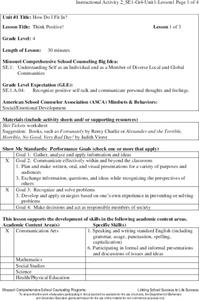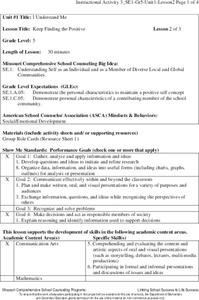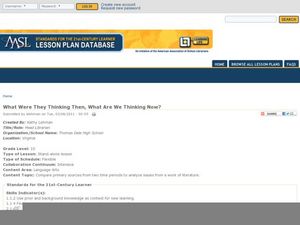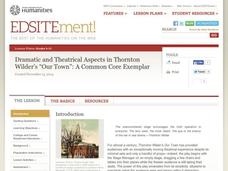US Institute of Peace
Negotiation Role-Play
War-torn Kosovo is experiencing another crisis—thousands of broken-down cars clogging the damaged highways, making travel impossible. Which local auto shop owner will get the contract to clear the road for progress? After some research,...
EngageNY
End-Of-Unit 2 Assessment: On-Demand Analytical Essay About How Esperanza Changes Over Time
Close the unit on Esperanza Rising with an in-class analytic essay on how Esperanza changes over the course of the novel. Writers can use any of their notes and work from the unit as well as their drafts of the first two paragraphs of...
Scholastic
What Makes a Leader?
After creating a list of great American leaders from the last century and researching their lives, pupils will brainstorm aspects of leadership and discuss what traits may be shared by all leaders.
Hampton-Brown
From "First Crossing"
Young scholars look closely at four tales taken from the collection of short stories, First Crossing edited by Donald R. Galloby. While examining the life of four teenagers and the lives they lead as U.S. immigrants, your enthusiastic...
US Institute of Peace
Responding to Conflict: Negotiation Role-Play
After a lesson like this one, your class won't hesitate to negotiate! Pupils pair up and negotiate opposing sides of a conflict during the ninth installment in a 15-part series. Once they determine their wants and needs, individuals...
US Institute of Peace
Advanced Mediation Practice
What will become of the giraffes of Amali? Pupils participate in a large scale role-playing activity to study the art of conflict mediation. The lesson engages participants in the struggle between two countries and the animals caught...
Brigham Young University
Introducing the Text and Learning the Process of Script Analysis
Where do directors and set designers get their ideas so that the set they build creates the mood and atmosphere the director wants for a production? From the script! Introduce theater high schoolers to the script analysis techniques used...
California Department of Education
Preparing for My Future
Your future is what you make it! Eighth graders launch their career searches in the first of six career and college readiness lessons. Scholars research to discover their extracurricular options both in and out of school, then locate...
Missouri Department of Elementary
Think Positive!
Following an attention-grabbing read-aloud, scholars brainstorm ways they can change negative thoughts into positive thoughts. Small groups plan and perform a skit that showcases one of the new ideas to uplift one's feelings....
Missouri Department of Elementary
Keep Finding the Positive
Group members take on roles to create a positive classroom community. Learners perform their role—leader, recorder, presenter, timekeeper, encourager, and collector—in preparation for a formal presentation of their positive thinking...
Missouri Department of Elementary
Are You Balanced?
Balance scales create a strong visual of how an individual prioritizes one's self alongside their commitments to the community, school, and home. Scholars complete a graphic organizer then discuss their findings with their peers. A...
Curated OER
Introducing Literary Elements in Fiction
Identify literary elements in fiction. In this reading comprehension lesson plan, learners read the book Pigsty and record literary elements onto a graphic organizer. They specifically discuss the main characters and events in the text.
Curated OER
Who's Who
Ninth graders read a review three pieces of literature. They then compare and relate each piece to the time period in which they were written. Next, they consult different resources and explain how these sources are similar and different...
Curated OER
Examining Persuasive Literature
Examine persuasive literature and writing. In this persuasive literature lesson, pupils work through a variety of activities over the course of three weeks (each week is planned by day). The unit's purpose is to examine examples of...
Curated OER
Multiple Perspectives
Analyze multiple perspectives in short stories. Sixth graders examine the point of view of each major character in three different short stories. After reading the stories, they role-play characters and hypothesize about the character's...
Curated OER
Introduction to Drama
Introduce your class to drama! You cast each pupil as a different character from a story you have read. They are given a general outline of the scene, act out the scene multiple times, then discuss the weak and strong aspects of each...
Curated OER
What Were They Thinking Then, What Are We Thinking Now?
Choosing an issue from a play or novel, researchers find two primary sources from different time periods to compare how people's views have changed. Many questions are listed to guide young writers. In the end, learners produce a...
National Endowment for the Humanities
Dramatic and Theatrical Aspects in Thornton Wilder’s “Our Town”: A Common Core Exemplar
“So I’m going to have a copy of this play put in the cornerstone and the people a thousand years from now’ll know a few simple facts about us.” Our Town is used as the text in a Common Core exemplar that examines the dramatic and...
Star Wars in the Classroom
"Shakespeare and Star Wars": Lesson Plan Day 2
Ta DUM, ta DUM, ta DUM, ta DUM, ta DUM. The force will be strong in the hearts of your young Jedi as they use their lightsabers to strike the accentted syllables in lines from Ian Doescher's William Shakespeare's Star Wars: Verily, A New...
Curated OER
Performing a Play
Students discover logical deduction by participating in a play. In this reasoning lesson, students act as characters from a play who's words must be analyzed to see if they are true or not. Students perform parts of the play and...
Curated OER
The Lion, The Witch, and The Wardrobe: A Literature Evaluation Project
Sixth graders read and analyze The Lion, The Witch, and The Wardrobe. They study the elements of literature found in the book. Students create an elements of literature flip book that shows the various elements of literature in the novel.
Curated OER
Number the Stars, Lesson 3
Students consider how an author creates a feeling of suspense in a reader's mind. They analyze characters in the story. Students make a character map for Peter. They discuss how suspense unfolds in the novel Number the Stars.
Curated OER
Twain: Tom Sawyer—Mythic Adventurer
Students take a closer look at archetypes. In this characterization lesson, students examine the setting and the characters of The Adventures of Tom Sawyer as they read and analyze the novel. Students consider how Twain mythically...
Curated OER
Tall Tales
Students examine the characteristics of tall tales and how exaggerations are used. They create a character that is larger than life, they brainstorm attributes for their character, before writing a Tall Tale. They plan out their story,...
Other popular searches
- Analyze Characterization
- Analyze Character Traits
- Analyze Characters
- Analyze Character Activities
- Analyze Character Plot
- Analyze Characters and Plot

























